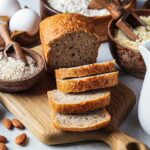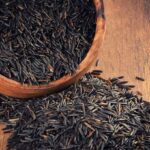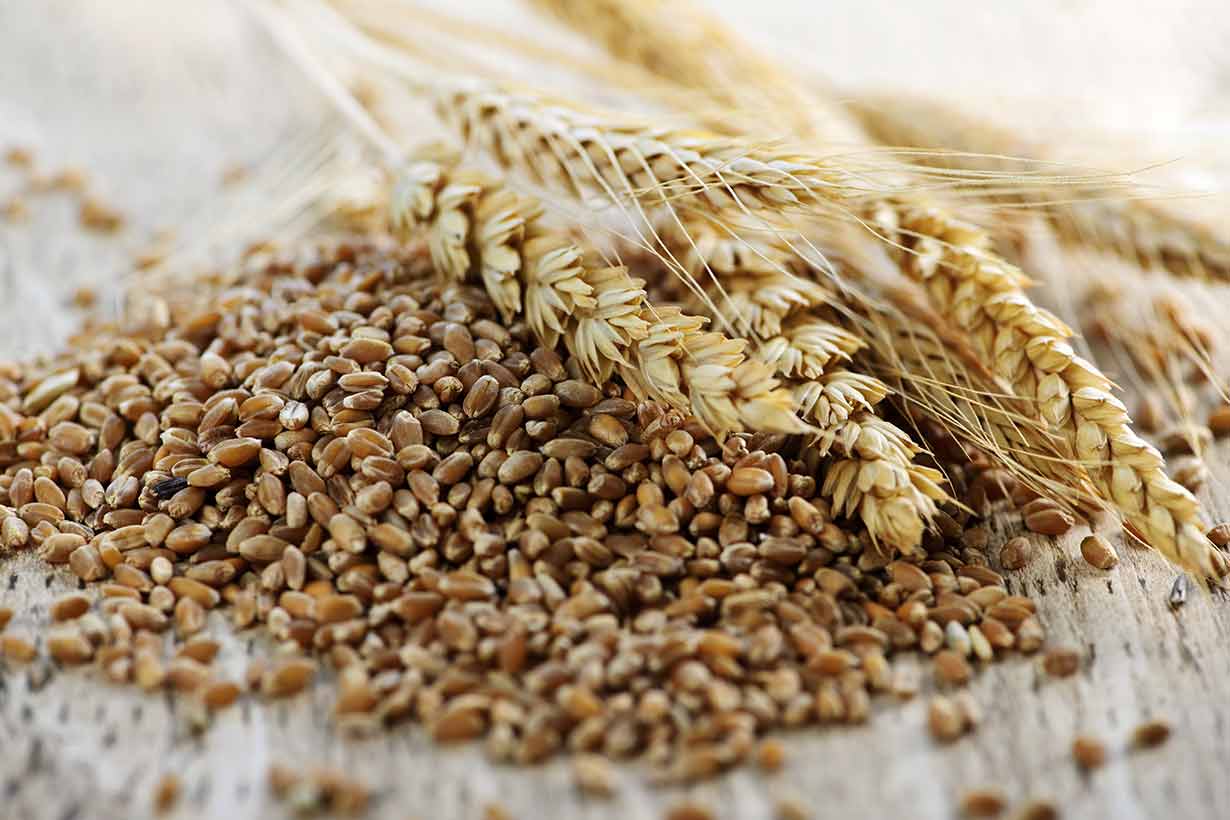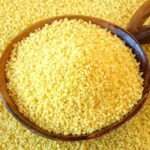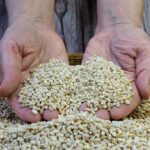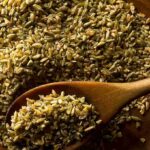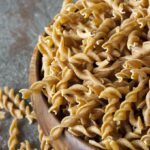Traditional German pumpernickel bread is a true whole-grain bread with the primary ingredient being rye.
It has a dark brown appearance and a dense, moist texture.
This article examines pumpernickel bread’s nutritional properties, potential benefits, drawbacks, and how it compares to other bread options.
Table of contents
The Nutritional Profile of Pumpernickel Bread
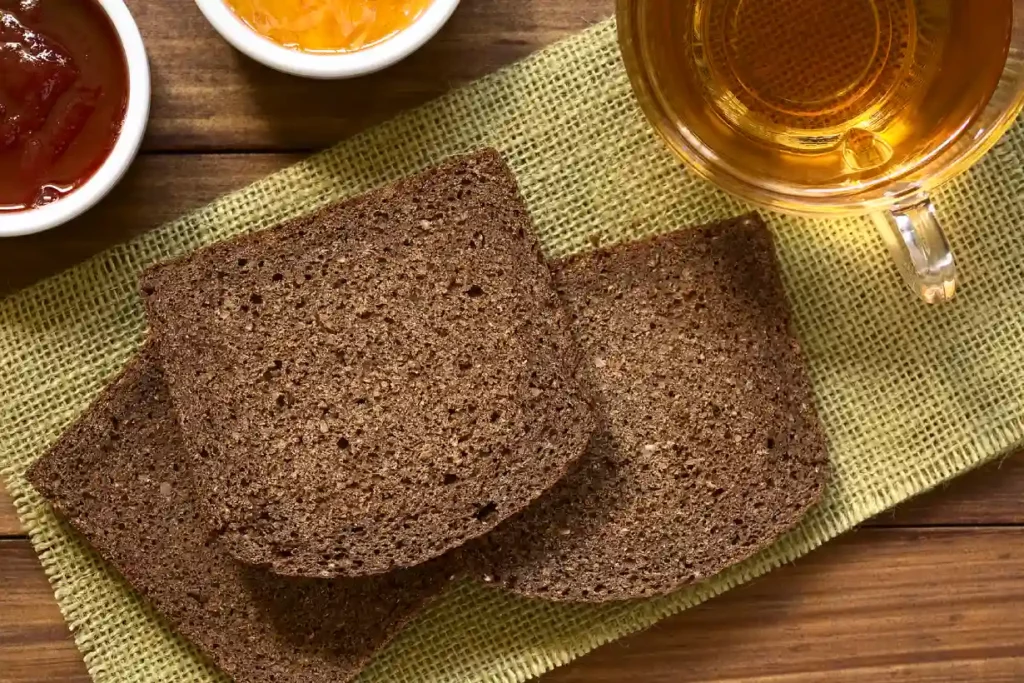
Let’s take a look at the key nutrients pumpernickel contains.
According to USDA data, 100 grams of pumpernickel provides 250 calories, 47.5 grams of carbohydrate, 6.5 grams of fiber, 3.1 grams of fat, and 8.7 grams of protein (1).
However, a typical serving is one slice, which weighs approximately 26 grams.
Here is the nutritional data for a 26-gram slice of pumpernickel bread (1):
Calories and Macronutrients
- Calories: 65 kcal
- Carbohydrate: 12.4 grams (5% of the daily value (DV))
- Fiber: 1.69 g (6% DV)
- Sugars: 0.14 g
- Fat: 0.81 g (1% DV)
- Saturated fat: 0.11 g (1% DV)
- Monounsaturated fat: 0.24 g
- Polyunsaturated fat: 0.32 g
- Omega-3: 0.02 g
- Omega-6: 0.30 g
- Protein: 2.26 g (5% DV)
Pumpernickel is primarily a source of carbohydrates—including fiber—and offers a small amount of protein.
While pumpernickel has a high carbohydrate content, it is less than most common bread options—see how different breads compare nutritionally here.
Vitamins
- Folate, DFE: 34.8 mcg (9% DV)
- Thiamin (B1): 0.09 mg (8% DV)
- Riboflavin (B2): 0.08 mg (6% DV)
- Niacin (B3): 0.80 mg (5% DV)
- Pantothenic acid (B5): 0.11 mg (2% DV)
- Vitamin B6: 0.03 mg (2% DV)
- Vitamin E: 0.11 mg (2% DV)
- Choline: 3.8 mg (1% DV)
- Vitamin K: 0.21 mcg (<1% DV)
- Vitamin A, RAE: 0 mcg (0% DV)
- Vitamin B12: 0 mcg (0% DV)
- Vitamin D: 0 mcg (0% DV)
Minerals
- Manganese: 0.34 mg (15% DV)
- Selenium: 6.37 mcg (12% DV)
- Copper: 0.08 mg (9% DV)
- Sodium: 155 mg (7% DV)
- Iron: 0.75 mg (4% DV)
- Phosphorus: 46.3 mg (4% DV)
- Zinc: 0.39 mg (4% DV)
- Magnesium: 14 mg (3% DV)
- Calcium: 17.7 mg (1% DV)
- Potassium: 54.1 mg (1% DV)
Note: The exact nutritional profile may vary slightly depending on the recipe and ingredients used.
Key point: Pumpernickel bread is a good source of fiber and provides a range of vitamins and minerals in moderate amounts.
Benefits of Pumpernickel Bread
Based on both its nutritional composition and research findings, here are some of the potential benefits of pumpernickel bread.
1. Lower Glycemic Index Than White Bread
The glycemic index predicts how quickly eating a carbohydrate-containing food will cause blood sugar levels to rise (2). For instance, a glycemic index of 100 would be similar to the effect of consuming pure glucose, whereas a score of 5 would indicate almost no blood sugar response.
Some bread options can be relatively high on the glycemic index. For example, white bread has a high glycemic index of 75 (3, 4).
Since pumpernickel bread is primarily made from whole-grain rye, it has a higher fiber content and should result in a lower glycemic response.
This should make it a better alternative for individuals who are monitoring their blood sugar. On this note, the American Diabetes Association has referred to pumpernickel as a bread that produces “relatively flat glycemic responses” (5).
However, findings from scientific research have reported that pumpernickel bread has a glycemic index that ranges from 41 to 78 (6, 7).
This variation in the reported glycemic index of pumpernickel bread is likely related to the ingredient profile of the bread tested. While traditional German pumpernickel consists of whole rye and a sourdough starter culture (8), some products deviate from the traditional recipe.
For example, a branded pumpernickel bread made by Safeway in the United States has wheat flour as the main ingredient—not whole-grain rye. This product also contains caramel color as an additional ingredient to help provide the dark brown traditional color of pumpernickel made using rye (9).
To ensure you are buying a traditional pumpernickel bread, check the ingredients label carefully. If buying from a bakery, ask the baker which recipe they follow—a German bakery would be more likely to make pumpernickel the traditional way.
A Study on Pumpernickel Bread’s Impact on Blood Sugar
A small randomized controlled crossover trial published in 2013 investigated the blood sugar impact of four types of bread (10).
These breads were consumed in a fasted state by 11 participants with type 2 diabetes, and they included pumpernickel, white bread, whole wheat buttermilk, and wholegrain bread.
Notably, pumpernickel bread led to the lowest rises in blood glucose and insulin out of the four breads.
As always, results from a small study should be taken cautiously. While the results are promising and align with what we may expect based on the blood sugar impact of whole grains, they need confirmation from larger studies.
Key point: Traditionally made pumpernickel bread made with whole rye grains should have a lower glycemic index than white bread.
2. Contains High Amounts of Fiber
Since traditional pumpernickel bread contains all the bran, germ, and endosperm of the whole rye berry, it has a high fiber content.
As shown in the nutritional profile, a 26-gram slice of pumpernickel bread has 1.69 grams of fiber, and the bread offers 6.5 grams of fiber per 100 grams (1).
According to data from the USDA database, this means that pumpernickel provides more fiber than most other types of bread. The following table provides an at-a-glance reference (1, 11, 12, 13):
| Variety of bread | Fiber content per 100 grams |
|---|---|
| Pumpernickel bread | 6.5 g |
| Whole-wheat bread | 6.0 g |
| Rye bread | 5.8 g |
| White bread | 2.4 g |
As we can see from this table, USDA data shows pumpernickel bread as containing more fiber than whole wheat, rye, and white bread.
Fiber has many potential benefits, including its potential to:
- Lower LDL (low-density lipoprotein) cholesterol, which may decrease the risk of cardiovascular disease (14).
- Bind and eliminate toxins and potential carcinogens in the intestines (15).
- Reduce rises in blood sugar after a carbohydrate-containing meal (16).
- Act as a food source for beneficial bacteria in the gut, which can ferment fiber into short-chain fatty acids. These fatty acids, such as butyrate, are associated with health benefits (17).
Key point: Pumpernickel bread contains more fiber than other common bread choices, which can offer various health benefits.
3. A Rich Source of Manganese and Selenium
Pumpernickel bread contains particularly high amounts of the minerals manganese and selenium, with just one slice offering 15% and 12% of the recommended daily value (based on a 2000-calorie diet) respectively (1, 18).
Manganese is important for helping produce energy, and it also plays a key role in protecting the body’s cells against oxidative damage (19).
Selenium also has vital importance for the body’s antioxidant system. It forms part of selenoproteins that protect cells against damage from free radicals (20, 21).
Key point: Pumpernickel is an excellent source of manganese and selenium.
Is Pumpernickel Bread Different From Rye Bread?
While the two breads may appear to sound similar, there are some key differences between traditional pumpernickel and regular rye bread.
The first difference entails traditional pumpernickel being made 100% with rye and without wheat, whereas rye bread typically contains a blend of the two.
Additionally, pumpernickel is slow-baked in steam-filled ovens for many hours. A baking time of approximately 14 hours would not be unusual in this regard (24).
As mentioned earlier, not all pumpernickel bread available on store shelves is the traditional variety, so check the ingredients label carefully to confirm this.
Making traditional pumpernickel bread entails mixing whole rye berries and cracked rye or coarsely ground rye with water, salt, a sourdough starter culture, and then sealing the mixture in a tin and slowly steam-baking it.
Does Pumpernickel Have Any Drawbacks?
Like most foods, pumpernickel has some potential downsides as well as its beneficial aspects, and we’ll examine these now.
1. Contains Gluten—Not Suitable for Celiacs and Individuals Sensitive To Gluten
Like wheat, rye contains a gluten-containing protein. This protein found in rye is called secalin (22).
Gluten triggers inflammatory immune responses in individuals with celiac disease, making pumpernickel bread—as a source of rye—unsuitable for these individuals (23).
Any individuals with a sensitivity to gluten should also avoid pumpernickel bread.
2. May Not Suit Some Taste Preferences
White bread and some whole grain breads can have a relatively bland and mild flavor, but pumpernickel bread is a complete contrast to this. Pumpernickel has a rich and deep flavor with a complex, earthy aftertaste.
Whereas some bread has very little flavor and complements sandwich fillings, pumpernickel can overpower other flavors. This isn’t necessarily a bad thing, and many people enjoy the flavor profile of pumpernickel bread.
However, it would be fair to state that pumpernickel is an acquired taste, just as other strong-tasting foods like dark chocolate, black coffee, and citrus fruit can be.
3. More Expensive Than Most Bread Options
As earlier stated, pumpernickel bread requires slow steam-baking, which traditionally happens over many hours.
Additionally, whole grain rye is significantly more expensive than wheat flour.
In other words, the process of baking pumpernickel bread—and the ingredients used—result in higher production costs. This translates to a higher retail price for the consumer.
Some may understandably be put off from purchasing bread with a significantly higher price tag. In this case, other “healthier” bread options include whole wheat bread and rye bread.
Key point: Pumpernickel bread isn’t suitable for everyone; its gluten content, price, and strong flavor may limit who can enjoy it.
Is Pumpernickel Bread a Healthy Choice?
Pumpernickel is a good source of fiber, manganese, and selenium, while also containing a range of vitamins and minerals in smaller quantities.
The bread is reasonably nutrient-rich, with a single 26-gram slice providing more than 5% of the daily value for eight vitamins and minerals.
For those who have no issues with gluten-containing foods, pumpernickel bread can be a nutritious addition to the diet.

